Exploring the North – Looking South: On a bottle of wine and into the ocean
But the Arctic isn’t the only place that’s important for the planet. Just on the other side of the planet, there’s another precious region: Antarctica. Why? Antarctic glaciologist Kenichi Matusuoka from the Norwegian Polar Institute explains this with the help of a bottle of wine.
Imagine holding a bottle of wine. The wine inside the bottle is very precious (and expensive), compared to the rest of the bottle – the glass body and the bottle cork. The wine corresponds to the ice in Antarctica: It is important for the planet as its melting could lead to a rise of 45 meters in sea levels.
Now imagine you turn the bottle upside down – the previously unimportant cork now becomes quite important as otherwise the precious wine would pour out. You can well imagine that the cork is now crucial, whether or not it’s a crumbly old cork that is only plugged loosely in the bottle neck, if you want to find out whether the wine will pour out or not.
That is why scientists focus on investigating the properties and melting behaviour of ice shelves, which is what the cork corresponds to. To be correct: Antarctica does not only have one “cork” like a bottle has, but several – those on top behave differently. But the overall research question is, whether climate change weakens the corks/iceshelves so intensely that they cannot withstand the pressure of the wine/Antarctic ice and finally might let it pass.

Antarctica from space: Blue-pinkish coloured are the ice shelf regions, where ice flows quicker than on land-grounded ice (Photo credit: NASA/JPL-Caltech/UCI)
During my travels in the Arctic region, I actually met a researcher who worked on the dynamics of Antarctica’s ice shelves. Tore Hattermann investigated the melting of a certain ice shelf underside. To get back to the cork analogy, you can imagine that it is rather crucial what size the cork has. If it’s too slim, the wine behind can easily push it away.
In West Antarctica, for example, a change in ocean circulation leads to warmer water below the ice shelves that starts to melt, contributing to more than two thirds of Antarctica’s mass loss. Now, computer simulations predicting that those circulations also transport warm water below the Fimbul ice shelf suggest additional melting. The Fimbul ice shelf is located not in the West, but in the East and has similar geographic conditions as the melting Western shelves have.

Tore Hattermann working on Antarctic ground – attentively observed by a penguin (Photo: Johan Hustadnes)
So, together with other scientists, Tore went on an Antarctica expedition to see whether the simulations are correct and if they could really find warmer water underneath the Fimbul ice shelf. Using boiling water, they drilled holes through 400 meters of ice and passed oceanographic instruments into the ocean below. Over two years those instruments measured water properties: its flow velocity, temperature, salinity and oxygen content. After analyzing the data collection, Tore could prove that the computer simulation was wrong: There was not that much warm water circulating under the Fimbul ice shelf, therefore it wasn’t melting at the extent predicted.
For most people this might seem a disappointment, but for scientists this is rather routine: proving models (wrong). In order to improve or adjust the models in the next step, therefore they depict reality better and predict Antarctic ice shelf melting correctly.

I did not want to deny you this drawing, as sometimes pictures say more than words. That’s this issue explained in a(n abstract) picture. Savvy?
Watch out for the next issue to find out, what the expedition to Antarctica was like for Tore.
Earth Day 2013 – the day google releases the tiny bears
Today is Earth Day, a day to raise the awarness for climate protection and to make clear we don’t have a backup-earth waiting in the cellar if we have wasted this one. The Earth Day movement is has quite a long tradition, this year it’s 43 years old, a milestone Google dedicates one of it’s occasional doodles.
Also these dedications have a long tradition, starting with two aliens looking at our planet in 2003 over melting polar ice in 2007 up to animated flowers in 2012.
This year’s the design is more elaborate. You will see a scene of hills with snow-capped mountains and a lake teeming with fish, bears peeping out caves, rain falling from clouds if you click them. It’s playfull, cute and may work as a mind-opening tool to make sure everyone knows what gem we live on.
Google has started a few efforts lately to support a greener environment. It’s funded renewable energy projects and published its carbon footprint for the first time.
Earth Day was born in the US in 1970. It’s idea is to activate “individuals and organizations to strengthen the collective fight against man’s exploitive relationship with the planet.”
Earth Day was born in the US in 1969, presented as a concept at the UNESCO conference in San Francisco. It’s idea was and still is to activate “individuals and organizations to strengthen the collective fight against man’s exploitive relationship with the planet.”
At the same time Gaylord Nelson U.S. Senator from Wisconsin back then thought about a national day of the environment after witnessing the ravages of the 1969 massive oil spill in Santa Barbara, California. The idea became popular, so since 1970 “Earth Day“ became a regular and steady growing event. During the 1990s the day crossed borders and became what it is today, a worldwide supported day in honor of the earth.
Exploring the North – Further North
Arriving in Tromso, Norway, we are now located just at the Arctic’s doorstep. It is a quiet strange feeling, when you suddenly stand at the edge of something, that is normally so incredibly far away. If it’s far away from you as well and you derive from that that you don’t have to care – hang on. You actually should, as the Arctic often is referred to as earth’s air conditioner. And on hot summer days without (working) air conditioning, you feel perfectly well what it is good for.
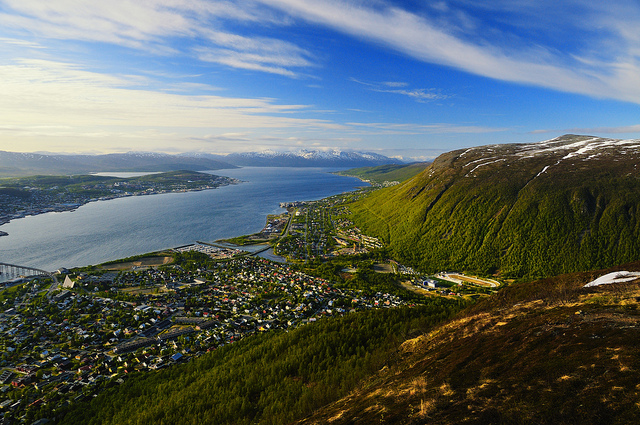
Thought you might have seen enough snow, so I found this Tromso view of June 2010 for you (Photo: CC-BY-NC-SA-2.0: Nietnagel)
If you look at such pictures of the Arctic region it does not at all like an air conditioning. I was actually suprised that it can be that green in the Arctic region, as I always associate of snow and ice with Artic. What about you?
But this ice is only there in winter time – that’s when it fulfils it’s cooling job, by reflecting 80 percent of sunlight back to space which then cannot heat up the ocean or earth anymore. But from March on, ice starts melting due to increasing temperatures. The decreasing sea ice cover uncovers the dark oceans that absorbs the sunlight instead of reflecting it – the cooling air conditioning turns into a heating facility.
So far, the Arctic yet hasn’t been completely ice-free during the warm summer period. But you might remember scientists worrying last summerabout the small area that is left ice covered: The larger the ice free part, the more heat is absorbed by the ocean underneath – in turn, even more ice melts and a vicious circle starts.
Not on the edge of the Arctic, but on the edge of Arctic research, you find scientists working on how this influences the Arctic environment. Sometimes this influence can even be positive: Researchers recently found that microbes in the soil can fix more carbon in a warmer climate.
But yet, researchers cannot tell how Arctic ice cover will evolve, but they work for example on better models to predict what is going to happen. That is especially important, as many earth systems are connected: A warming Arctic sea also affects ocean currents for example, that – connected to each other – span over the whole planet. In turn, oceans take up less CO2 for example, and in consequence more of this greenhouse gas in the air, warms up the whole planet.
Exploring the North – Lighting up the dark
Being out in the nowhere around Abisko also has a major advantage: due to the very small light pollution, you might get the chance to see what the polar region is famous for: the Northern lights.
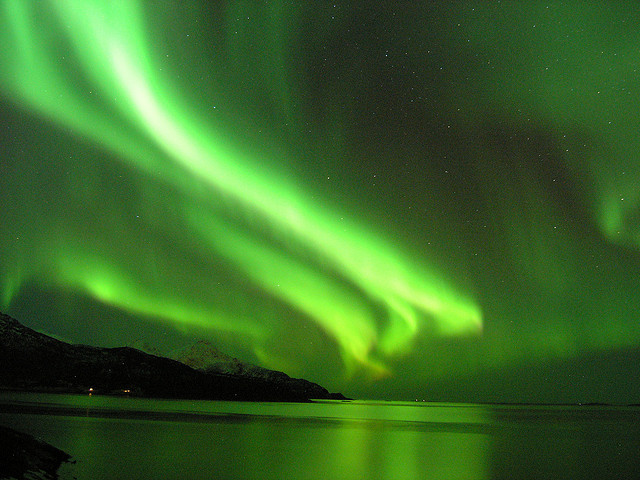
When solar particles hit the earth’s atmosphere, sky starts to shine (Photo credit: CC BY SA 2.0: Gunnar Hildonen)
In one sentence: Northern lights occur when cosmic radiation meets the molecules of our atmosphere. In a few more sentences: Such radiation normally comes from the sun, being the closest active star around. When this so called solar wind hits the earth’s magnetic field with more than 700 kilometers per second (!) it’s particles are torn apart into charged particles which spans electric tension over the earth. This tension is discharged as the particles run along the earth’s magnetic field towards the poles, where this field is the strongest (This is also the reason why you can’t see the lights all over the world: the further you move from the poles, the lower is the chance to actually see the lights).
In 150km heigth those charged particles hit the earth’s atmosphere, and thereby pass some part of their energy onto the molecules of earth’s atmosphere, which – finally – stimulate them to glow. Which colour the lights have differs from height and the atmosphere’s composition.
There also might be a yte loose connection to climate change: There is a theory that this beautiful natural phenomenon helps to cool the earth. Due to the ionization of the air, also clouds might be formed and in consequence insulate the earth from warming rays of sunlight.
Exploring the North – Visible signs of climate change
Almost in the middle of nowhere, where just a few houses stand between trees around the lake, there is kind of a research nest. Scientists from different countries live and work together in Abisko, Sweden, to investigate the impact of climate change in the Arctic region.
That is especially feasible, as the research station is located North of the polar circle. The Arctic region is far more sensitive to climate change than others: While globel mean temperature yet rose by 0.8 degrees celsius, the Arctic already warmed by more than one degree on average.
“If you came here 40 or 50 years ago, you would see that the treeline has risen since then”, says plant ecologist Ann Milbau.
Also the composition of species growing here has changed: mosses do worse, while more grasses growing on the vast ground. But in the last years, researchers suddenly walked on a green moving carpet – made of caterpillars. Temperature in the previous winter did not fall below -35°C, a threshold above which all caterpillar eggs survive. The eclosed moths ate away all leaves from the trees. “There was nothin green here in summer”, Milbau says, “But yet we don’t know, whether this was just an exception or really a sign of climate change.”
Which visible signs of climate change can you see in your environment?




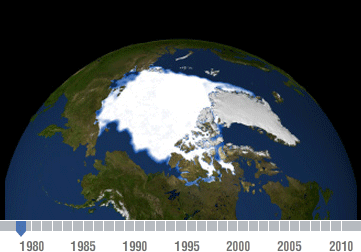
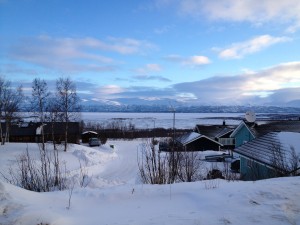
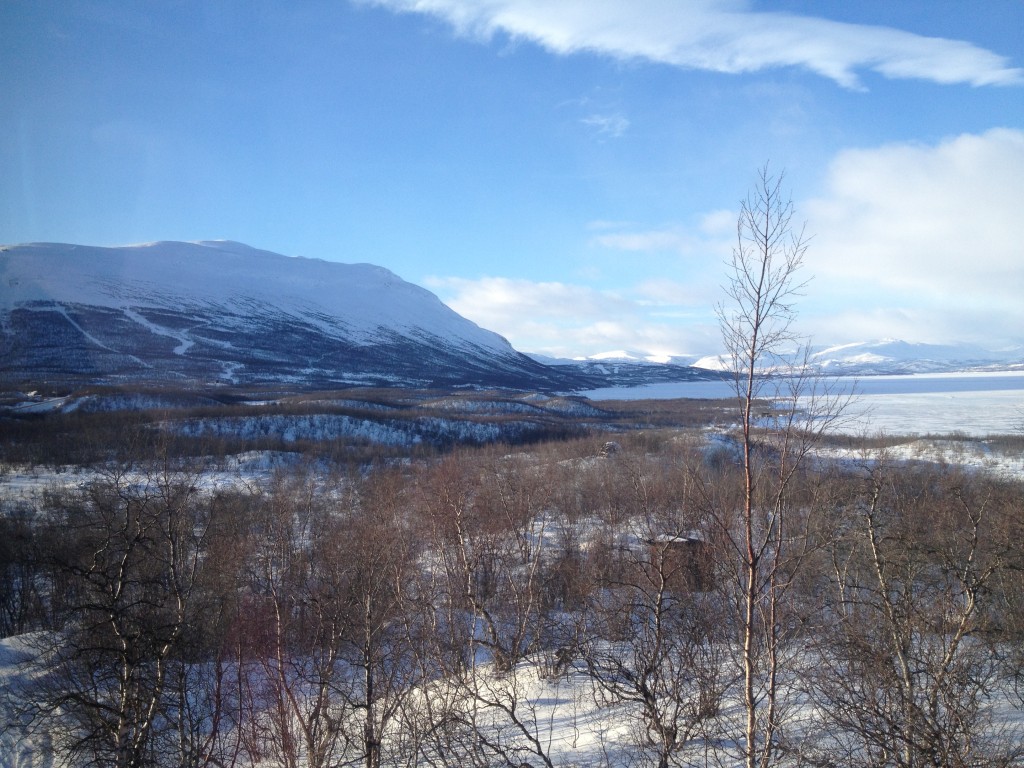




Feedback